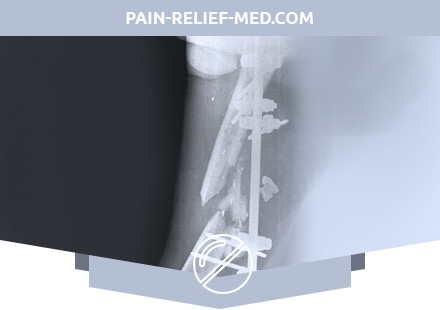 What are Gunshot Fractures in Combination with Soft Tissue Defects in a Limb?
What are Gunshot Fractures in Combination with Soft Tissue Defects in a Limb?
Obviously, the final reposition of fragments during gunshot fractures in combination with soft tissue defects is possible only after the elimination of the inflammatory process and cleansing the wound from necrotic discharge. It is fundamentally important to combine the treatment of soft tissue and bone wounds with the simultaneous closure of skin defects, for example, by the method of non-free skin grafting. Such victims need well-designed and balanced infusion therapy.
Pathogenesis during Gunshot Fractures in Combination with Soft Tissue Defects of the Limb
Most often, injuries of the brachial artery are found, and from the venous trunks, the internal jugular vein is more often damaged. It is characteristic that at present, surgeons are increasingly resorting to the vascular suture of the vein when it is wounded and less often to ligation, although it cannot be said that the suture of the vein is much more difficult technically and in terms of long-term results than the suture of the artery.
Damage to the veins, both isolated and in combination with injuries of the main arteries, is observed mainly in young people, mainly in men. The amount of blood loss when injuring the main veins can range from several hundred milliliters to 1-2 liters or more. A significant number of such patients may come with signs of severe blood loss requiring immediate resuscitation. Perhaps, to a greater extent than with injured arteries, in case of damage to the main veins, specialized angiological assistance is needed. The suture of a large vein, as emphasized, is incomparably more complicated than the suture of an artery.
Bleeding with any damage to the vein can be intense, especially with pelvic fractures, when a blood loss of 1.5-2 liters is not uncommon.
Diagnosis of Gunshot Fractures in Combination with Soft Tissue Defects in the Limb
As an effective measure for the difficult diagnosis of damage to the main vein, arteriophlebography can be recommended. It is advisable to use rheovasography, polarography, phlebography in its pure form as additional diagnostic measures.
Treatment of Gunshot Fractures in Combination with Soft Tissue Defects in the Limb
During operations on the limbs, immobilization is most often carried out in a bent position to reduce the tension of the seams. Here you can choose this option: venous autoplastic insertion between the central end of the popliteal artery and the end of the anterior tibial artery, then, if possible, an anastomosis end to the side between the venous insertion and the end of the posterior tibial artery. The popliteal vein should be bandaged.
In case of a hip fracture in combination with a femoral artery wound, initial osteosynthesis is crucial, and vascular suture or autovenous plastic should be performed last. It is advisable to use plates of CITO-SOAN for closed fractures for osteosynthesis.
Damage to veins, both isolated and in combination with injuries of other anatomical structures, primarily arteries, require restoration of the integrity of the venous wall of large veins, axillary, femoral, first of all. In this case, patches from a free venous autograft or autovenous inserts are used.
In the case of thrombosis of the anastomosis, reconstructive intervention should be immediately taken, the anastomosis should be revised, the causes of occlusion should be eliminated.
At the prehospital stage, in case of damage to the main vein, preference should be given to applying a good pressure dressing.
The danger of applying a tourniquet proximal to a vein wound is known – it is realistically to receive increased bleeding. The frequency of thrombosis of the main veins after operations on them ranges from 20 to 50% or more.
When applying venous anastomoses, it is necessary to carefully observe the surgical technique. When stitching veins of different diameters, an essential condition is that the length of the applied anastomosis should be at least 3 diameters of a smaller caliber.
If pelvic fractures are accompanied by severe bleeding that cannot be stopped, you can resort to unilateral or bilateral ligation of the internal iliac arteries, although the effect of this procedure is problematic.
